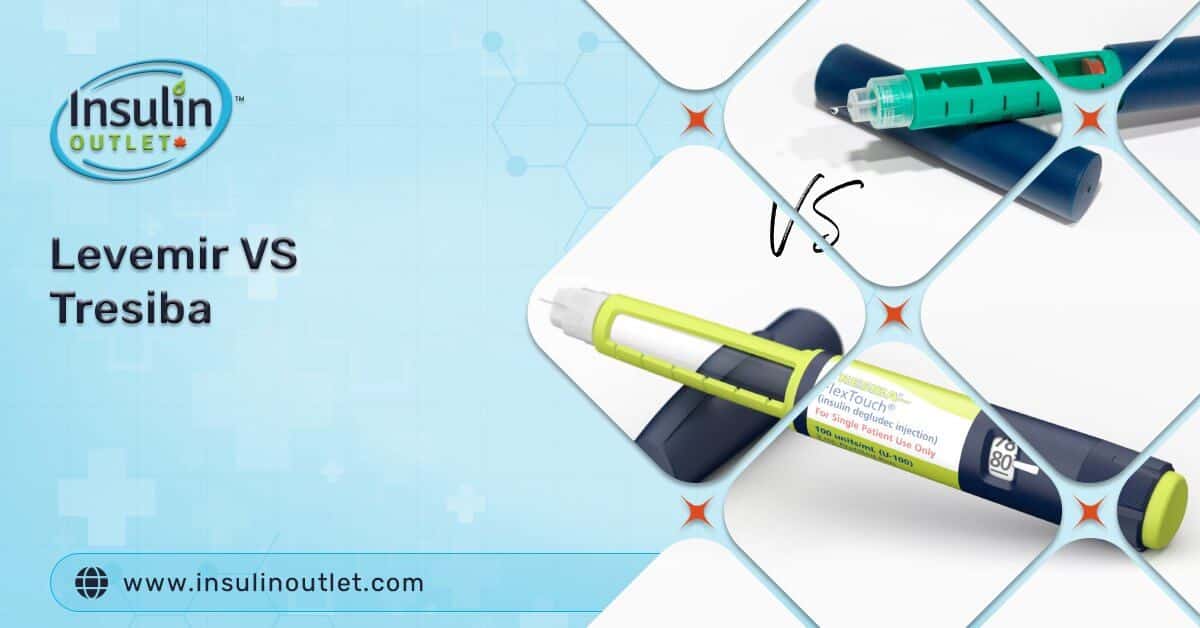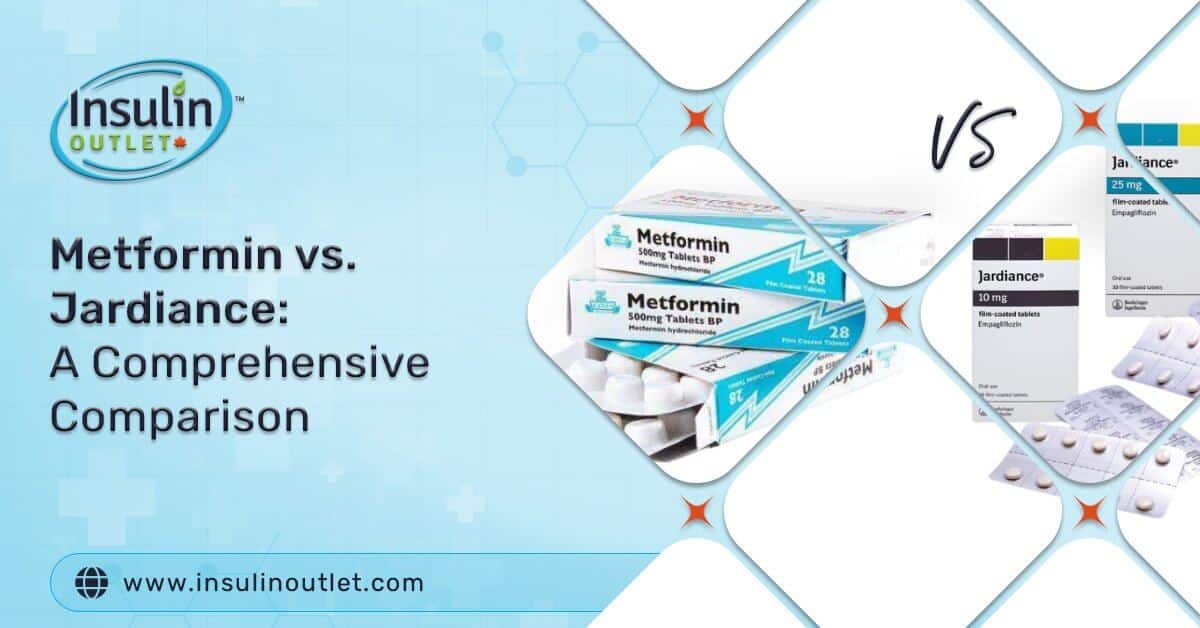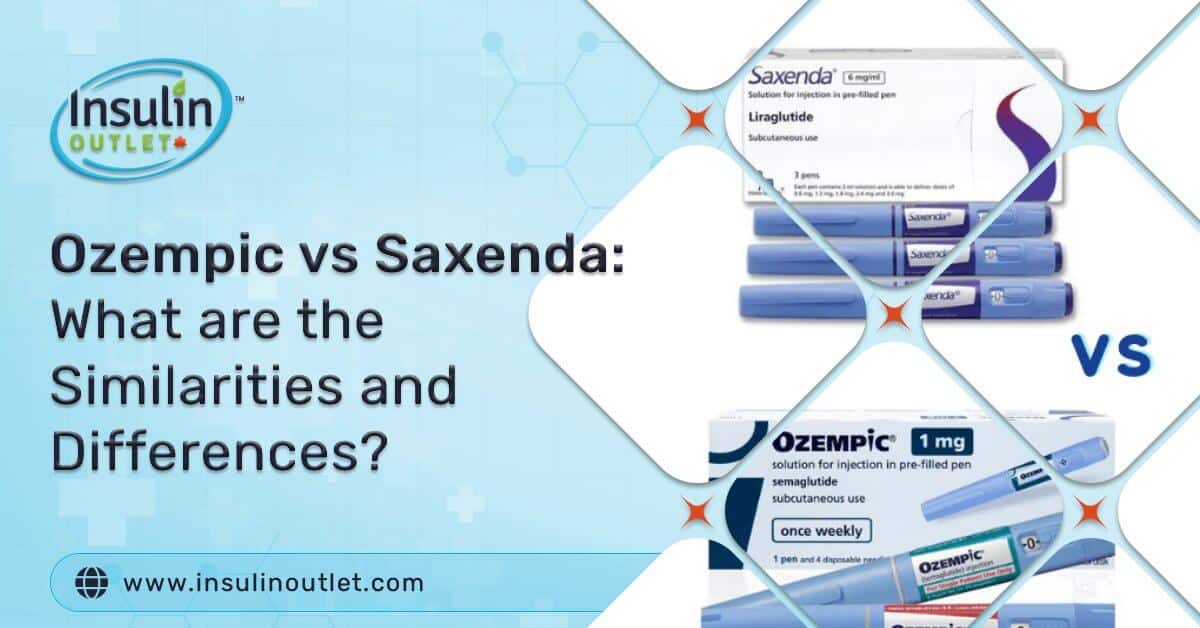
Levemir and Tresiba are two leading options for long-acting insulin, designed to help those with diabetes maintain stable blood sugar levels. Both offer unique benefits and potential drawbacks, which is why if you’re considering these two diabetic medications, it’s important to understand the differences between them.
Here’s a look at how Levemir and Tresiba compare:
Levemir (insulin detemir) and Tresiba (insulin degludec) are long-acting insulin analogs used to control blood sugar levels in people with diabetes. These medications are formulated to provide a consistent, round-the-clock supply of insulin, helping to mimic the way a non-diabetic pancreas releases insulin.
They are both basal insulins, meaning they are administered once or twice daily to provide a steady, baseline level of insulin. They are often used in conjunction with rapid-acting insulin analogs, which are taken at mealtimes to control blood sugar spikes after eating.
Comparing Levemir vs Tresiba
Duration of Action
Levemir works for 24 hours and peaks around 6 to 8 hours after injection. Tresiba, on the other hand, lasts up to 42 hours, with a steady effect throughout the day.
This longer duration offers more flexibility in dosing and may lower the risk of nighttime low blood sugar (nocturnal hypoglycemia). However, individual responses can vary based on age, kidney function, and overall health.
Administration and Dosing
Levemir is typically administered once or twice daily, based on individual needs. The usual starting dose for insulin-naïve patients is 10 units once daily or 0.1-0.2 units per kilogram of body weight.
It can be injected subcutaneously into the thigh, abdomen, or upper arm. However, it’s essential to rotate the injection sites to prevent lipodystrophy, which are changes in the skin at injection sites. Levemir is available in two pen devices: the FlexPen and the FlexTouch.
Tresiba, on the other hand, offers greater dosing flexibility due to its ultra-long duration of action, lasting up to 42 hours. This insulin is administered once daily at any time, with at least 8 hours between doses.
It’s available in U-100 and U-200 concentrations, with the maximum dose per injection being 80 units for U-100 and 160 units for U-200. This flexibility in dosing times can be particularly beneficial for those with varying daily schedules.
Effectiveness
When it comes to blood sugar control and A1C reduction, both Levemir and Tresiba have proven to be effective long-acting insulin options. However, there are some notable differences between the two.
Levemir (insulin detemir) has been shown to provide effective blood sugar control and lower A1C levels in adults and children with type 1 and type 2 diabetes. In clinical studies, Levemir lowered HbA1c in a range typically observed in similar long-acting insulins, and effectively reduced fasting blood sugar over a period of several weeks.
Tresiba (insulin degludec), on the other hand, is often reported to offer a more consistent and extended blood sugar control compared to Levemir. Clinical studies suggest that Tresiba may enhance A1C reduction and maintain more stable blood glucose levels over a longer duration, particularly benefiting those who require a robust and flexible dosing schedule.
It is also noted for its potential in reducing nocturnal hypoglycemia, making it a viable option for patients who need reliable overnight blood sugar management.
Cost
When it comes to cost, Levemir (insulin detemir) tends to be more affordable than Tresiba (insulin degludec). However, the exact prices can vary depending on your insurance coverage, location, and pharmacy.
It’s important to check with your insurance provider to understand your out-of-pocket costs for each insulin option. Some insurance plans may cover one insulin better than the other, or they may have different co-pay or coinsurance rates.
Additionally, manufacturer assistance programs or discount cards may be available to help offset the costs of Tresiba for eligible patients.
Pros and Cons of Levemir and Tresiba
Levemir (Insulin Detemir) | Tresiba (Insulin Degludec) | |
Pros | – Less likely to cause weight gain compared to other insulins – Dosages can be customized to fit individual requirements – Available in easy-to-use insulin pens – Effective for up to 24 hours | – Very effective at controlling blood sugar levels – Flexible dosing schedule, can be taken at any time – Adjustable dosages based on individual needs – Pens can be used for up to 56 days at room temperature – Portable and compact pens – Utilizes one of the smallest needles available |
Cons | – Requires injection – May need to be injected twice a day – Risk of hypoglycemia (low blood sugar) – No generic version available | – Needs to be injected – May lead to weight gain – Risk of hypoglycemia (low blood sugar) – Only available as a brand name, making it costly |
Considerations for Choosing Between Levemir and Tresiba
When it comes to selecting between Levemir and Tresiba, there are several key factors to consider:
- Dosing schedule and flexibility: Tresiba offers more flexibility in dosing, as it can be taken at any time of day, with or without meals. Levemir, on the other hand, is typically dosed once or twice daily, often in conjunction with meals.
- Duration of action: Tresiba has a longer duration of action, lasting up to 42 hours, which can provide better blood sugar control with fewer injections. Levemir has a shorter duration of action, lasting up to 24 hours, which may require more frequent dosing.
- Risk of Hypoglycemia: Studies have shown that Tresiba may have a lower risk of hypoglycemia (low blood sugar) compared to Levemir, particularly at night. This can be an important consideration for those who are prone to hypoglycemic events.
- Lifestyle and convenience: If you prefer a more flexible dosing schedule or have a busy lifestyle, Tresiba may be a better option due to its longer duration of action and the ability to take it at any time of day.
- Cost and insurance coverage: The cost of these insulin treatments can vary, and insurance coverage may play a role in your decision. Be sure to check with your insurance provider to understand the out-of-pocket costs associated with each option.
- Individual response: Every person’s response to insulin can be different. Some individuals may find better blood sugar control or fewer side effects with one insulin over the other. It’s important to work closely with your healthcare provider to monitor your response and make adjustments as needed.
Final Thoughts
Levemir and Tresiba are both long-acting insulin analogs used to control blood sugar levels in people with diabetes. While they share some similarities, there are notable differences in their characteristics and usage.
When choosing between Levemir and Tresiba, it’s essential to consider factors such as the duration of action, administration methods, side effects, cost, and individual preferences.
Tresiba may be a better option for those seeking a more flexible dosing schedule or experiencing issues with hypoglycemia, while Levemir may be preferred for its affordability or familiarity.
Ultimately, the decision should be made in consultation with a healthcare provider, taking into account your specific needs, lifestyle, and overall diabetes management plan. Regular monitoring and adjustments may be necessary to achieve optimal blood sugar control and minimize the risk of complications.
Frequently Asked Questions
What should I know about converting from Levemir to Tresiba?
Converting from Levemir (insulin detemir) to Tresiba (insulin degludec) involves understanding the differences in dosing and duration of action. Tresiba generally offers a longer duration, potentially reducing the frequency of injections. Consult your healthcare provider for personalized conversion advice to ensure optimal blood sugar control.
What is the difference between Levemir Flexpen and FlexTouch?
The main difference between the Levemir FlexPen and FlexTouch lies in their injection mechanisms. The FlexPen requires the user to dial the dose and manually inject, while the FlexTouch features a spring-loaded mechanism that requires less force, making injections easier, especially for individuals with hand strength limitations.
What are the equivalents for Tresiba and Levemir in insulin therapy?
In terms of function, other long-acting insulins like glargine (Lantus, Basaglar) can be considered equivalents to Levemir, offering similar blood sugar control over a 24-hour period. Tresiba’s equivalent would be other ultra-long-acting insulins, though its unique dosing flexibility and duration make it distinct.
Can Tresiba be split into multiple daily doses for better blood glucose management?
Tresiba is designed for once-daily dosing due to its long action profile, which can last from 42 up to 72 hours. Splitting the dose of Tresiba is generally not recommended as it is formulated to provide a stable and consistent insulin level throughout the day and night with just one injection.
However, some individuals experiment with their dosing times and amounts to better align with their lifestyle or body’s response, but such adjustments should always be made under medical supervision.
Share:














